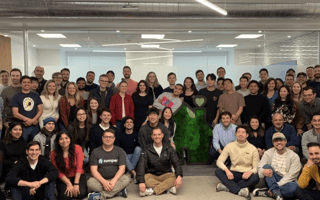
What comes first: the product or the market?
This is the question startup founders face when deciding to break ground on a new business venture. Some leaders are driven by the desire to reinvent a certain market, while others are simply motivated by an innovative product idea. Nevertheless, finding the perfect match between a product and a market is not always easy to achieve — but when it happens, it sets the foundation for success.
In order to find the perfect product-market fit, leaders must take into account the needs of the consumer, making the process a sometimes long — albeit enlightening — one. By assessing customer feedback and identifying pain points, creators can bring their ultimate product ideas to fruition.
Of course, that doesn’t mean the product will always be the exact same. Whether it’s real estate or healthcare, industries change over time, and for this reason, products must meet the market’s evolving needs.
Built In San Francisco caught up with three local tech leaders to learn how they found their product-market fit and how they’ve adapted to evolving market needs.
Zumper aims to transform the rental industry by making renting an apartment “as easy as booking a hotel.” Apartment-seekers can use their platform to search for verified properties, reserve them on the spot and lease them online.
Head of Product Nico Rattazzi talked about why Zumper’s founders decided to reinvent the rental market, the importance of understanding customers and how their product changed over time.
Which came first for you: the product or the market?
For us, the market came first. We knew the apartment rental market is a massive, multi-billion dollar market, but to us, the product experience was poor. Our founders started the company because of the stressful and antiquated experience of finding a house or apartment for rent. For us, that meant working with as much of the market as possible in order to invest in the experience of making apartment rentals as easy as booking a hotel. This meant understanding renters and landlords and focusing on providing an experience that leverages incredible technologies.
By having a two-sided marketplace at scale, we’ve finally arrived at our current product experience focus known as “Instarent.” This is our first attempt at scale to provide a high-quality digital leasing experience. This involves ensuring quick and direct correspondence via our marketplace and providing leasing through a streamlined flow of screening and applications as well as lease signing. The landlord gets a qualified renter with additional financial insurance to ensure they’re covered for twelve months. By understanding the pain points of the market and growing the tools for landlords and renters, we are able to deliver a product that provides a different level of service compared to the classic rental marketplace.
Product-market fit is all about understanding the customer and addressing their needs.”
Tell us about your process for fine-tuning product-market fit. What's one aspect of that process you find is particularly important?
Product-market fit is all about understanding the customer and addressing their needs. Getting a deeper understanding of our customers has allowed us to build products for the fragmented market experience that defines renting. For us, it’s critical to understand the needs of our customers while we are undergoing our product process for all of our roadmap items. This involves understanding how customers are currently addressing a problem through research, including conversations, surveys and product data.
Once we have identified the problem and begin developing our solution, we check in with our customers again to validate our solution and ensure we’ve developed something that works for them. This can be as simple as running our customers through the interface over video or having them interact with a prototype. The feedback we get from our customers is invaluable at this stage, as it ensures we’re on the right track and reduces the risk of launching the wrong solution. This process, and specifically research around the problem space and validation of the solution, has allowed us to step into our customers’ shoes.
How did your original vision for the product evolve or change to better address the needs of the market?
When we started, we wanted to drive connections in our marketplace by bringing renters and properties together. This meant developing product features and growth strategies to find renters and properties to bring together. Now that we’ve become the largest independent rental marketplace in our space, we’re shifting our product focus to deliver on the needs of the market and, ultimately, our original vision. By working directly with both sides of the marketplace, we’re able to not only provide the best matches based on preference but provide that with an incredible end-to-end digital experience.
Opendoor is on a mission to “empower everyone with the freedom to move.” Currently operating across 21 U.S. markets, the company enables people to buy, list, sell, tour or trade-in homes online.
Co-founder and Chief Technology Officer Ian Wong spoke about Opendoor’s aim to fix the “fragmented” real estate industry and how they reshaped their product to meet the needs of the market.
Which came first for you: the product or the market?
The market came first. Buying and selling a home represents one of the largest financial transactions in people’s lives, yet it’s often a very stressful experience. The real estate ecosystem is fragmented. It’s fraught with misaligned incentives, and customers historically report low net promoter scores. At Opendoor, we believe a vertically integrated solution that delivers a simple and seamless transaction experience will deliver outsized value to customers.
We have a core hypothesis that customers crave certainty, convenience and speed.”
Tell us about your process for fine-tuning product-market fit. What's one aspect of that process you find is particularly important?
We have a core hypothesis that customers crave certainty, convenience and speed. In the early days at Opendoor, our goal was to “wow” our customers with solely the description of the product: “Sell your home within a few clicks of a button.” And we were looking for strong reactions, not lukewarm ones. This signaled that the product direction was worth pursuing.
How did your original vision for the product evolve or change to better address the needs of the market?
Our vision for the company has always been, and still is today, to empower everyone with the freedom to move. As our first product gained traction, we were able to address additional, unmet needs and wants that many homeowners and home shoppers have. This led us to expanding our suite of products and developing the services we offer today. We provide a one-stop shop for consumers to list, sell, tour, buy, trade-in and finance homes for an integrated and frictionless experience from start to close and everything in between.
Fivetran wants to make it easier for companies to access their data from different sources. The company enables businesses to make data-backed decisions by utilizing fully automated connectors that sync data from applications, databases, logs and more into a cloud warehouse.
Vice President of Product Fraser Harris discussed Fivetran’s product-market fit journey, the importance of focus and his thoughts on the data market.
Which came first for you: the product or the market?
Like many great startup stories, Fivetran’s product-market fit came in 2015 when our earliest customer told us to drop what we were doing and focus on the one thing they were willing to pay us for. A couple of months later, we had ten customers. A year later, we had 100. Five years later, we have 1,500.
Figure out what your customers really value, and then relentlessly focus on improving along that singular dimension.”
Tell us about your process for fine-tuning product-market fit. What's one aspect of that process you find is particularly important?
Focus. Figure out what your customers really value, and then relentlessly focus on improving along that singular dimension. As a result, we dominate in the top two buying criteria for our product and leave the rest of the market to fight over the other less valuable buying criteria as a differentiator, which includes price.
How did your target market shift as your product vision became more clear?
For a number of years, we didn’t believe the market was big enough, and we thought we would have to expand into other adjacent products. And yet, with every year of focus on our one great problem, we realized the total addressable market was ten times larger than we thought.










